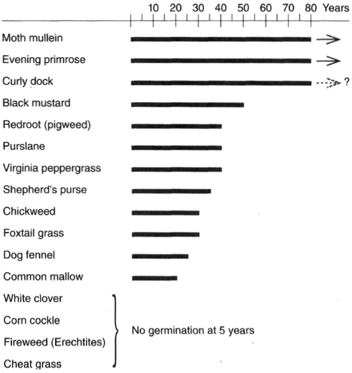Seed Longevity
 |
| Table 36-1 The Longevity of Seeds Based on W.J. Beak Experiment Begun in 1879 at Michigan State College. |
There is also great variation in seed longevity among plants. The seeds of elms, magnolia, and soft maple remain alive for only several days; the seeds of willow and poplar survive for several weeks; and the seeds of a number of species, especially weeds, remain viable for many years. In 1879, Professor W.J. Beal of Michigan State College (now Michigan State University) initiated a long-range experiment whereby seeds of twenty common plant species were mixed with sand and put in storage. Every five years, seeds of each species were taken up and tested for viability. Because the viability proved more than expected, the time period was extended to ten years so as not to run out of stored seeds. The results of this experiment are shown in table 36-1.
Seeds of certain bean-family plants have been removed from herbarium specimens known to be more than one hundred years old and have been successfully germinated. An incredible example of seed longevity was exhibited by Nelumbo nucifera seeds recovered from an ancient bog in Manchuria, which were germinated and grown to full flowering. Radio carbon dating of such seeds confirmed them to be no less than one thousand years old. The life expectancy of seeds is much affected by storage conditions. Keeping seeds dry during storage is vital to longevity.




